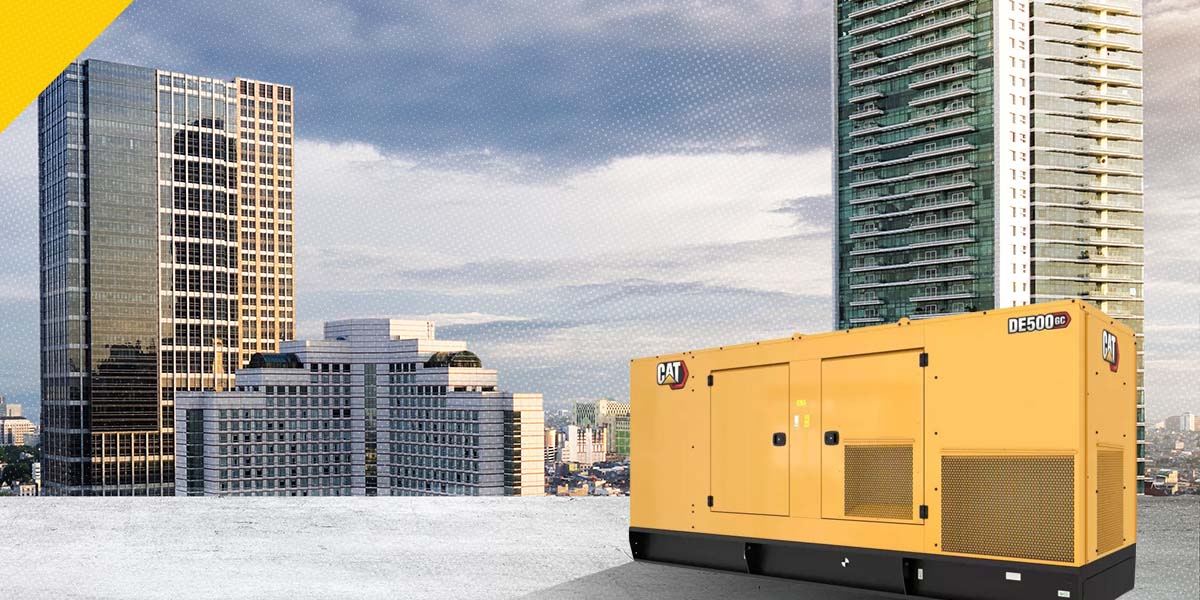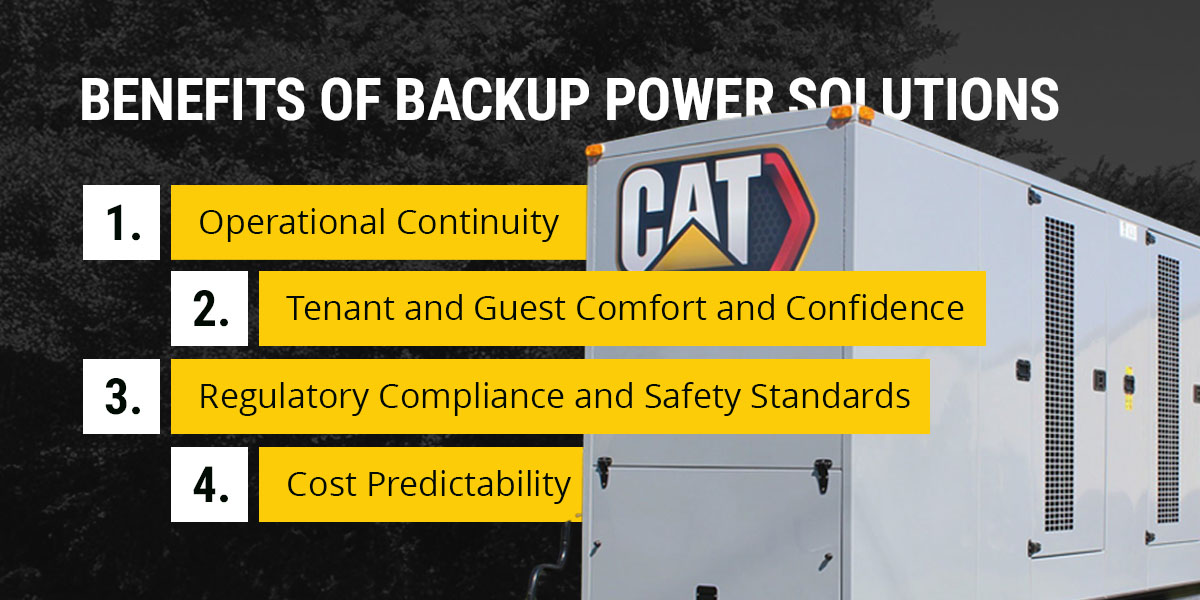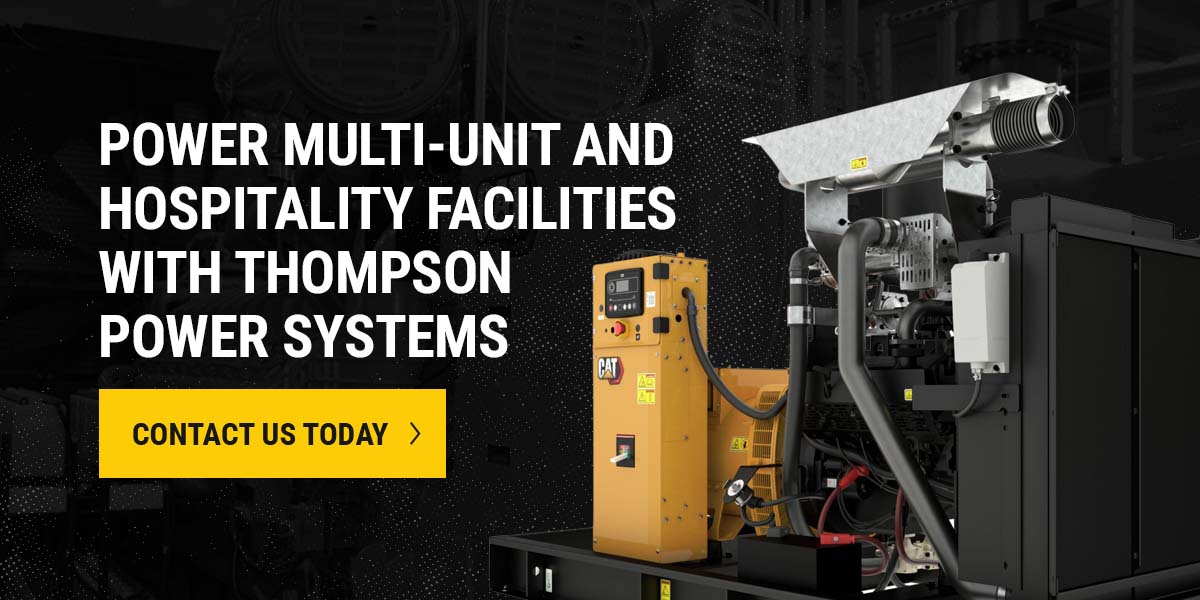

In multi-unit and hospitality facilities, reliable power is critical to safety, regulatory compliance, resident comfort, and operational continuity. As buildings grow more complex, so do the demands on their power infrastructure.
If you are managing or upgrading these facilities, you should have a power system that sustains load requirements, redundancy, and code compliance. Learn about power requirements for multi-unit and hospitality facilities below.
Hotels operate as self-contained systems. Power systems in these environments support guest accommodations, commercial kitchens, conference centers, and amenities.
Hotels have constant and variable load demands. Some systems run constantly, while others surge during peak hours. Critical systems like elevators, emergency lighting, and fire alarms must stay online during a grid failure.
The National Fire Protection Association (NFPA) 110 standard and local codes are typically followed for hotel backup power requirements. NFPA 110 outlines emergency and standby power system performance requirements. National Electrical Code Article 700 requires emergency systems to be powered independently.
A hotel standby generator should support safety, comfort, and revenue-generating services. These typically include:
Power reliability in multi-residential buildings is a necessity. Property owners need systems capable of powering multiple units and staying on during outages. In multi-unit dwellings, electrical demand varies throughout the day, but tenants should be able to depend on stable power for:
Apartment buildings operate continuously. Aside from individual units, building owners and management teams must also account for power usage in lobbies, hallways, gyms, laundry rooms, leasing offices, and exterior lighting.
Local building codes and national safety standards govern apartment complexes’ emergency power requirements. For example, the NEC Articles 700 and 701 mandate emergency and standby power for life safety systems. This means generators for apartment complexes should sustain the following components during an outage:
Assisted living facilities support the health and well-being of residents, and part of that is providing power continuity to create a safe, livable environment. A temporary outage could compromise medical support and regulatory standing.
Regulatory guidance for assisted living facilities is clear about the role of emergency power systems. NFPA 110 sets the baseline for how emergency and standby power systems must perform, including response time, routine maintenance, and reliability during outages. Additionally, NEC Article 700 mandates that essential systems must have an independent power source.
The following systems typically require emergency or standby power to meet legal obligations and ethical responsibility:
Businesses should balance cost, capacity, and regulatory requirements when designing a backup system for multi-unit and hospitality complexes. Here are some solutions that provide even power distribution and long-term serviceability:
Backup power is an investment in occupant safety and long-term business viability. Explore the value of these solutions below.

Unexpected outages can bring facility operations to a halt. For example, that might mean inoperable elevators, HVAC systems, or keycard access in a hotel. In an apartment complex, it disrupts daily life for residents.
With backup power infrastructure, multi-units and facilities can maintain essential services, minimize downtime, and preserve the environment that residents and guests depend on.
Power reliability can impact how your facility is perceived. Residents expect their facilities to remain safe and livable regardless of what’s happening on the grid. Families entrusting loved ones to a senior care facility want assurance that critical systems will remain functional.
When power systems are maintained and responsive, it signals professionalism and care. This builds confidence among residents, guests, and stakeholders.
Local, state, and federal regulations mandate standby or emergency power systems. Failing to meet these requirements can lead to fines or revoked licenses.
Reliable backup power supports compliance with relevant codes. It also helps meet requirements for emergency lighting, fire suppression, and other life safety systems. Having a backup power mitigates risk and strengthens a facility’s regulatory posture.
While power infrastructure requires an upfront investment, it provides control over a business’s critical operating risks. Power disruptions can incur emergency repairs or lost business.
Backup power solutions allow operators to manage peak loads and avoid the costs of reactive service. This creates a more predictable cost structure and provides budget certainty for maintenance and operation teams.
Facilities that plan for power continuity position themselves to meet tenant expectations and operational stability.

Thompson Power Systems has over 65 years of experience providing high-quality power solutions. Our work spans diverse industries across Alabama and northwest Florida. We offer various dependable solutions designed to meet facility operational demands.
We’re locally based and responsive, with a regional footprint allowing fast, hands-on support. Our team works closely with yours to assess your site’s needs, size the right equipment, and deliver a system that meets regulatory and utility requirements. When you partner with us, you get a leader who understands your sector and is committed to offering support after the installation.
Contact us today for a power generator for hotels, apartment complexes, or assisted living facilities.